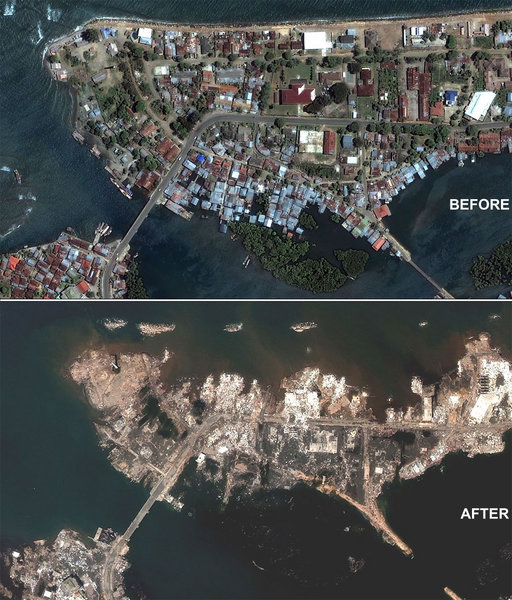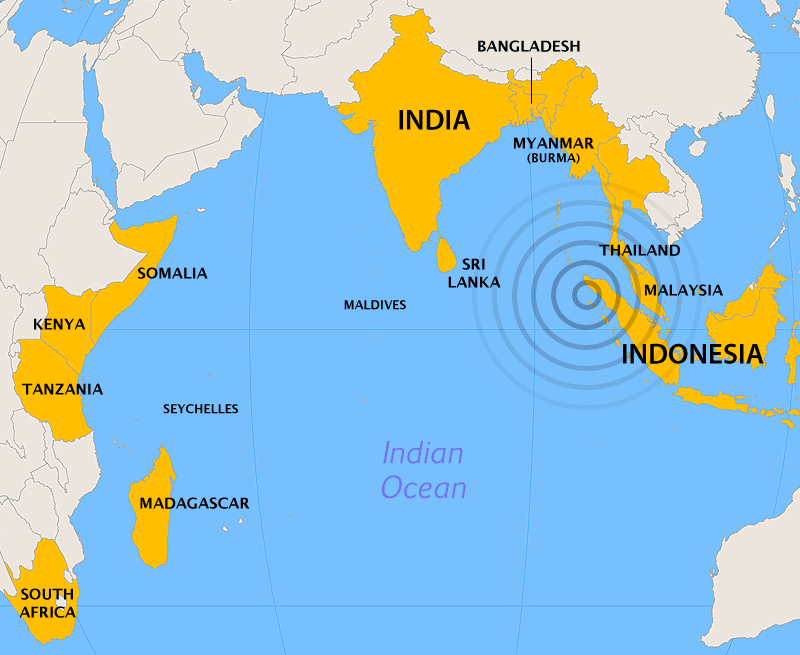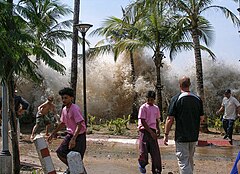The 2004 Indian Ocean earthquake was an undersea
megathrust earthquake that occurred on Sunday, 26 December 2004, with
an epicentre off
the west coast of Sumatra, Indonesia. The quake is known by the scientific community as
the Sumatra–Andaman earthquake. The resulting tsunami is
given various names, including the 2004 Indian Ocean tsunami, South
Asian tsunami, Indonesian tsunami, and the Boxing Day tsunami.
In May 2005, scientists reported that the earthquake
itself lasted nearly ten minutes when most major earthquakes last no more than
a few seconds and it caused the entire planet to vibrate at least a few centimeters.
The earthquake originated in the Indian Ocean just north of Simeulue island,
off the western coast of northern Sumatra, Indonesia. The resulting tsunami
devastated the shores of Indonesia, Sri Lanka, South India, Thailand and other countries
with waves up to 30 m (100 feet). It caused serious damage and deaths as far as
the east coast of Africa, with the furthest recorded death due to the tsunami
occurring at Port Elizabeth in South Africa, 8,000km (5,000 miles) away from
the epicentre.
Approximately 200,000 to 310,000 people are thought to
have died as a result of the tsunami, and the count is not yet complete. In
Indonesia in particular, 500 bodies a day were still being found in February
2005 and the count was expected to continue past June. The true final toll may
never be known due to bodies having been swept out to sea, but current estimates
use conservative methodologies. Relief agencies warn of the possibility of more
deaths to come as a result of epidemics caused by poor sanitation, but the
threat of starvation seems now to have been largely averted. The plight of the
many affected people and countries prompted a widespread humanitarian response.
 |
| Devastation to Banda Aceh on the island of Sumatra as a result of the tsunami caused by the 2004 Indian Ocean earthquake. |
Areas
The major subduction zone is associated with the Pacific and Indian Oceans and
is responsible for the volcanic activity associated with the Pacific Ring of Fire. Since these
earthquakes deform the ocean floor, they almost always generate a
significant series of tsunami waves. They are known to produce intense shaking
for long periods, such as several minutes.
1. 2004 Indian Ocean earthquake and tsunami. (n.d.).
In Wikipedia, the free encyclopedia. Retrieved December 19,
2012, from
http://en.wikipedia.org/wiki/2004_Indian_Ocean_earthquake_and_tsunami
2. The Indian Ocean Earthquake & Tsunami of
2004: Will History Repeat Itself? | Britannica Blog. (n.d.). In Britannica
Online Encyclopedia. Retrieved from
http://www.britannica.com/blogs/2008/12/the-indian-ocean-earthquake-of-2004-will-history-repeat-itself/
3. Earthquake in the Indian Ocean Causes a Massive
Tsunami. (n.d.). Windows to the Universe. Retrieved from
http://www.windows2universe.org/headline_universe/earth_science/stories_2004/tsunami_news.html



